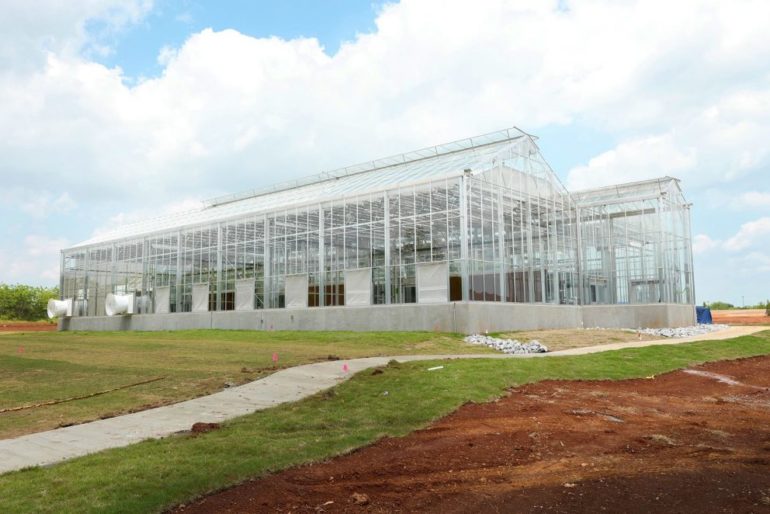By: Elizabeth Hobbs
The HudsonAlpha Institute for Biotechnology has a new building gracing its skyline– a 14,000-square-foot glass greenhouse to be exact. The highly sophisticated facility is equipped with two lab spaces, seven grow rooms with fifteen-foot ceilings, and several technologically advanced features rarely found in other greenhouses. The facility will help researchers in the HudsonAlpha Center for Plant Science and Sustainable Agriculture (Plant Center) advance their mission to use genomics to help sustainably feed and fuel our planet.
To put the greenhouse’s potential into perspective, imagine a chef preparing a meal. We are all familiar with the phrase “farm-to-table.” In an ideal scenario, an experienced, sophisticated chef would want the freshest ingredients, sourcing the best produce from a local farm, or even a personalized backyard garden.
A chef without access to local produce must acquire their ingredients from a supermarket. The store could be out of an ingredient, or the chef could’ve accidentally left an item off his list, not realizing until he has begun cooking in the kitchen. This creates unnecessary inconvenience and frustration, preventing the chef from efficiently preparing the meal they imagined in their head.
HudsonAlpha’s agricultural researchers previously faced similar circumstances– traveling inconvenient distances to greenhouses, with all of their equipment in tow, hoping they brought enough materials, and spending valuable time in transit instead of in the lab. The new HudsonAlpha greenhouse will solve these problems, allowing the Plant Center team to grow exactly the plants they need, under near-perfect conditions, right in their backyard.
Building the perfect greenhouse
The greenhouse development was inspired by the rapid growth of HudsonAlpha’s agricultural genomics program. The team quickly maxed out the space in its indoor growth rooms and set sights on a bigger goal: a full greenhouse.
The design and construction of the dream greenhouse were made a reality by greenhouse designer Albert J. Lauer, Inc. and construction firm Brasfield and Gorrie. It is one of only a few of its kind in the nation and is unique to HudsonAlpha because it was built for the researchers who will be using it, with their input and requests influencing the design. “The features here are unique because we were given the freedom to make design decisions based on our research needs,” said Kankshita Swaminathan, PhD, HudsonAlpha Faculty Investigator. “We have everything we might need in the new space. We asked lots of collaborators to contribute the lessons they’ve learned from their greenhouses, and they guided us in the customization and problem-solving process.”
The team is excited by the close proximity of the greenhouse and the freedom that will afford them. “With this greenhouse, the idea is any plant, any experiment, anytime,” said HudsonAlpha Faculty Investigator Alex Harkess, PhD. “The close proximity of the greenhouse means if we want to do a spontaneous experiment, we can.”
The Plant Center team started filling the rooms with their plants, with room to grow up to 500 in each unit. Peanuts, sunflowers, grasses, dahlia, and members of the papaya family are happily growing in their own rooms with customized climates and lighting schedules.
The team couldn’t help but brag about a few key components when asked about their favorite greenhouse features.
Seed Storage Vault — Adding to the list of technically advanced features in the greenhouse is a long-term seed storage vault. The Plant Center team works closely with preserved seeds that hold valuable genetic information about the plant’s history. These seeds must be stored in specific conditions to protect their viability. The greenhouse is equipped with a temperature- and humidity-controlled room for safely storing seeds for up to ten years. Many other greenhouses use large fridges or freezers, which can ruin an entire supply of genetic information if a malfunction occurs. HudsonAlpha’s seed storage uses special controls and a complex alarm mechanism that alerts the team of any changes in temperature or humidity.

Two Onsite Labs — An important component of the greenhouse is two on-site molecular labs, which Harkess said are rare. “This sets our greenhouse apart from the rest. With lab space in the greenhouse, we can spend much more time closer to our plants.” Harkess said. “Here, we embrace the philosophy of the more time you spend with your organism of study, the more you discover.”
HudsonAlpha Faculty Investigator Josh Clevenger, PhD, added, “Having lab space in the same facility as your plants allows you to do anything you can dream of doing. It means having no limitations.”
Lighting — To Clevenger, one of the most important features of the greenhouse is supplemental lighting. “We can simulate twenty hours of daylight using LED lights,” he said. LED lights are cooler and less of a hazard, and the lights’ color settings can be manipulated to simulate the sun setting and rising. “This means I can manipulate the flowering of my plants and minimize the time it takes to breed new peanut lines,” Clevenger added. There are shades separating grow areas so that each scientist can create the conditions required by their plants without interfering with those of the neighboring grow room.

Temperature and Air Regulation — One problem Swaminathan and the team noticed in other greenhouses is improper airflow and hot spots caused by low ceilings, poor ventilation, and inefficient heating systems. To optimize the air conditions in the greenhouse, the research team requested fifteen-foot ceilings, a floor heating system, and HEPA air filters. “Tall rooms should, in theory, create the perfect conditions. Height, light, floor heating, and high volume of moving air make the greenhouse more stable and prevents hotspots– which is very rare,” Swamination said. Not only do the tall ceilings assist with airflow, but they allow for the research team to grow larger, taller plants, like Swaminathan’s sugar cane.
Facilitating Citizen Science
The Greenhouse’s features extend outside its doors to a public demonstration garden. The Herb and Terry Lewis Demonstration Garden, situated in front of the greenhouse just off of the double helix trail at McMillian Park, extends the greenhouse’s features outside its doors.
The garden will feature a mixture of native plants, research plants that are also growing inside the greenhouse, as well as several carefully designed educational exhibits, to offer the public a hands-on learning experience. That way, members of the public can explore and admire the plants HudsonAlpha researchers are studying.

With the new greenhouse, the Plant Center team will be able to operate “farm-to-lab table” so to speak. Just as a chef with access to a thriving vegetable and herb garden can cook a five-star meal, the Plant Center team can now more easily and efficiently further their research with access to the Greenhouse.

